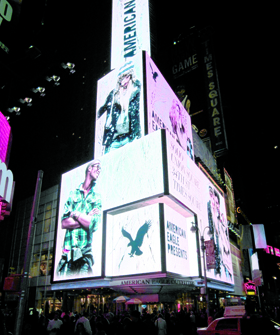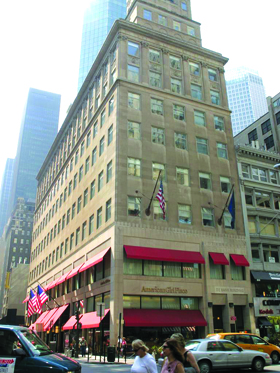When asked last month about investor Jeff Sutton, a spokesperson for a major commercial brokerage innocently responded: “Who’s that?”

The question is a telling one for someone who has in the last two decades built up a portfolio, mostly of New York City retail properties, that may be worth upward of $1 billion.
While Sutton is well known to the small community of retail brokers, investment sales players and other high-level executives in the industry, what’s surprising is just how many people in New York City real estate don’t know him, or his company, Wharton Properties.
Unlike other under-the-radar New York real estate titans like the late William Gottlieb or the late Sol Goldman, who shrouded their portfolios in mystery, Sutton is transparent about what he owns, and even lists every one of his more than 100 properties on his company’s website. And unlike many big-time building owners who take pains to hide their home address, he is listed by name in city property records as the owner of a 6,000-square-foot mini-mansion in the tightly knit Syrian Jewish enclave in the Ocean Parkway neighborhood of Brooklyn.
Yet Sutton is almost never quoted in the real estate-obsessed press — even as he actively buys, sells and builds properties.
“He doesn’t need it. I don’t think Jeff wants to be in the limelight. I think he likes being under the radar,” said retail broker Michael Friedman, the president of In Line Realty, who first met Sutton, now in his late 40s or early 50s, about 15 years ago, when Friedman was a broker representing shoe retailer Payless in the outer boroughs. “The guy has street credit.”
Sutton is everywhere, but nowhere: He was aware of this profile, but he declined to be photographed or quoted.
Still, his properties speak for themselves.
They are an impressive mix of less-than-glamorous retail sites in the outer boroughs — including many concentrated on major shopping drags — and trophy assets like the American Eagle Outfitters flagship store at 1551 Broadway in Times Square, the Armani store at 717 Fifth Avenue, and the American Girl Place building at 609 Fifth Avenue. A count of the 100-plus listings on his website show that 66 are mostly retail buildings on popular outer-borough strips like Roosevelt Avenue in Queens, Fordham Road in the Bronx and Fulton Street in Brooklyn.

Although his first high-profile deals were struck years ago, Sutton remained active even during the downturn, inking deals such as the $200 million lease earlier this year with AÈropostale at 1515 Broadway, and the $120 million lease in December 2009 with American Eagle Outfitters at 599 Broadway in Soho. He also teamed up earlier this year with longtime partner SL Green Realty to gain control of 11 West 34th Street.
And he currently has two prominent new construction developments in the works in Manhattan.
In Harlem, he’s partnering with NFL player turned real estate developer Emmitt Smith on a high-profile, 200-room Hyatt Hotel project on 125th Street and Lenox Avenue. Sutton is building the three-story retail portion at the base of the tower, where sources say Whole Foods may sign on as an anchor tenant.
Meanwhile, he’s also working with SL Green on 180-182 Broadway, a new, 23-story Karl Fischer-designed building with 7,500 square feet of retail on the ground floor, second floor and basement. Sources said Sutton also signed a deal with House of Hoops this year for about $600 per square foot at 11 West 34th Street, which would be the highest rent on a block where he is a dominant retail presence.
Getting to the basket
Sutton, the son of a retail products importer, started his career shopping for space for the discount shoe store Payless, which was looking to expand in the outer boroughs in the early 1990s.
Brokers said he would drive around with Payless executives who would point out exactly where they wanted to open. The problem, of course, was that many of those locations already had retail tenants.
In most instances when a location is not available, the broker moves on. In some instances, the broker can work out a sophisticated arrangement in which the landlord pays money to remove the existing tenant through a buyout or other means. But what Sutton did (at least in a number of cases) was more radical. Instead of convincing the landlord to buy out the existing tenant, he bought out the landlord.
Here’s how it worked: Payless would sign a lease for a property that they wanted, then Sutton would take that lease to a lender and get financing in order to buy the property. He then approached the landlord with an offer to purchase. While it didn’t work in every case, in many cases, after much wrangling, the owner sold the property to him.
Convincing landlords who had no intention of selling to sell is no easy feat, In Line Realty’s Friedman said. “He has that skill. How does Michael Jordan beat everyone to the basket?” he said.
Retail broker Chase Welles, an executive vice president at Northwest Atlantic, said Sutton told him that his acquisition formula often allows him to walk away with money at a closing, when most buyers are writing checks.
“He shows up [at the closing] with a lease signed by a tenant, that he has financed for more than what he is buying the building for,” Welles said.

The American Eagle building in Times Square
“[Sutton] has a great quote. He says, ‘When we are buying the building, everybody in my office jokes the last guy to know is the seller,'” Welles said.
Although first tested in the boroughs, Sutton adapted this technique to buy some of his trophy properties, including 720 Fifth Avenue, said David Rosenberg, managing partner at Deerwood Capital. Rosenberg was part of a team of mortgage brokers who obtained financing for the purchase of the building, where Abercrombie & Fitch is now the retail tenant.
“By the time he closed, the building was worth a lot more than he paid for it, with the lease,” Rosenberg said.
Jonathan Mechanic, chairman of the real estate department of Fried, Frank, Harris, Shriver & Jacobson, said Sutton’s strategy was not complicated or unique. But he noted it required retail tenants to trust him enough to sign a lease on a property Sutton did not yet own.
“There are other people who do that. But you need to have the relationships with the tenants in order to bring that to the table,” Mechanic said.
Mechanic was the attorney on the acquisition of 717 Fifth Avenue, in which Sutton partnered with Lloyd Goldman, Jeff Feil and Stanley Chera. Within two years of the deal, Sutton bought out those partners.
Robert Futterman, of Robert K. Futterman & Associates, said unlike many New York City building owners, Sutton takes a personal interest in visiting potential tenants during the wooing process. Futterman traveled with Sutton to Columbus, Ohio, to make the final pitch to Abercrombie & Fitch to locate their flagship store at 720 Fifth Avenue. The company signed a lease in 2004.
“It set the bar a little higher [in price] on Fifth Avenue,” Futterman said.
Getting sophisticated
Building on the strategy he used to make his first deal with Payless some 20 years ago, Sutton attracted the attention of CVS Pharmacy in the late 1990s. Like he did with Payless, Sutton found locations for the pharmacy, then bought those sites using the leases he got CVS to sign.
Then, in 2002, he made his first major headline-grabbing deal in Manhattan when he signed American Girl Place to his store at 609 Fifth Avenue, at the corner of 49th Street.
The deal was hard fought. Sutton bought the building — his first major purchase on the city’s premier Fifth Avenue shopping strip — without first having the tenant in place.
Investment sales broker Eric Anton, an executive managing director at Eastern Consolidated, noted that he bought the building for $65 million without a tenant paying a rent rate that justified the price of the property.
“He bought it on spec,” said Anton, who brokered the transaction. “That [deal] kind of put him on the map.”
In the summer of 2002, after Sutton bought the property, he took a flight to California to derail an advancing deal Mattel’s American Girl had with Tishman Speyer’s Rockefeller Center. He brought along videos comparing pedestrian traffic outside his location with clips outside the Rockefeller Center space, at the time occupied by clothing retailer Nautica, and now occupied by Anthropologie.

The American Girl building at 609 Fifth Avenue
“He made the CFO look at the two videos. He made it painfully obvious,” said Deerwood Capital’s Rosenberg.
The American Girl deal was a newsmaker in part because Susan Kurland, at the time a retail broker with Cushman & Wakefield, and now with CB Richard Ellis, won a Real Estate Board of New York award for the lease that included a so-called percentage rent payment — an additional cut on top of the base rent (see related story, “Profit sharing, with landlords”).
Anton said Sutton recognized that he could get far more in rent on the ground floor than what Korean Air, the longtime tenant, was paying. So Sutton arranged for Korean Air to move to a higher floor in the building, and bought out the building’s other tenants.
In Times Square, Sutton attracted American Eagle Outfitters to sign a 25,000-square-foot, multifloor lease at 1551 Broadway at 46th Street, a 2007 deal worth nearly $300 million. At the time, it was the most valuable lease ever struck in Manhattan, and is still perhaps worth more than the lease Japanese retailer Uniqlo signed with 666 Fifth Avenue in April, a deal reported to be valued at about $300 million.
Meanwhile, Sutton used a more sophisticated version of the video presentation, including clips of several busy upper-floor retail establishments, to convince AÈropostale to come to Times Square in SL Green’s 1515 Broadway, where Sutton controls the retail portion through a net lease. That lease was signed earlier this year.
While the ownership structure of Sutton’s 100-plus buildings is not known, his share for the 10 properties in which he is partnered with SL Green are public. According to those SL Green financial filings, Sutton has a 50 percent equity share in at least six of them. And in some, for example, 1551 Broadway, his stake can go as high as 90 percent if he hits certain performance targets.
Stepping on toes
It’s nearly impossible to be a major commercial player in New York without throwing elbows at times. And Sutton is no exception in that regard.
Nabbing American Girl was a coup, but it left Rockefeller Center owner Tishman Speyer licking its wounds, several brokers said.
While no one accused Sutton of unethical behavior in getting his win — in fact, some praised it as going the extra mile for a tenant — brokers said one result was clear.
“I remember Tishman Speyer was not happy,” said Futterman, who was Sutton’s agent on the lease.
While that deal ended with a high-profile lease, not every deal he touches goes smoothly.
Sutton was among a group of investors who got into a dispute with the Chera family’s Crown Acquisitions, and traded lawsuits with them over a competition to acquire the retail condominium of the St. Regis Hotel at 2 East 55th Street and the neighboring 697 Fifth Avenue from Starwood Hotels & Resorts Worldwide. The two sides settled, and Crown Acquisitions ended up partnering with BLDG Management and the Feil Organization to buy the retail condo in November 2009.

Sometimes leasing deals don’t pan out either. Faith Hope Consolo, the chairman of retail leasing and sales at Prudential Douglas Elliman, said she tried to get her client, Korean clothing store chain WHO.A.U, to lease in one of his stores on 34th Street, but the company balked at the rent and ended up across the street, at a building owned by the estate of Sol Goldman, for a much lower price.
“[Sutton] tried very hard. I could not persuade [the client]. They made their own decision,” she said. “His numbers are always aggressive. Not high — aggressive.”
A candy-store-size empire
From his modern offices on the 54th floor of a Midtown office tower, Sutton oversees his surprisingly small company, which has fewer than a dozen employees.
Friedman, of In Line Realty, compared Sutton’s small firm to a tiny retailer with profits comparable to a huge industrial giant. He said he didn’t believe Sutton wanted to manage a huge staff, or create a large company like SL Green or Related Companies.
Friedman said Sutton’s preferred lease structure is the triple net lease, which gives the tenant responsibility for paying taxes and other expenses on the property.
“Four walls and a roof,” he said, referring to Sutton’s low-overhead model. “He has no responsibility [for the upkeep of the properties]. That is brilliance.”
“How does a candy store have as much net worth as the actual manufacturer?”